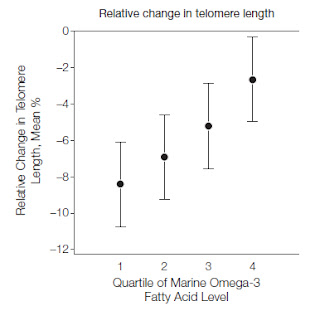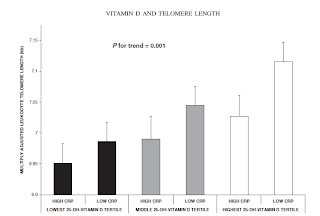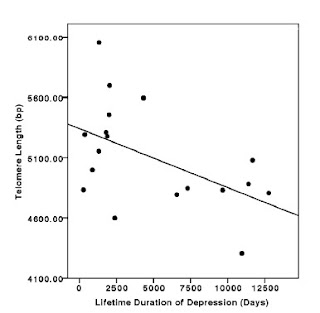 |
| Telomere length has a proportional and linear relationship to omega-3 fatty acids. |
With all the attention surrounding telomere length as a biomarker of biological aging, it’s worth pointing out that one nutrient may make a lot of difference: fish-derived omega-3 fatty acids.
The higher the blood levels of fish-derived omega-3 acids in patients with coronary heart disease, the longer the telomeres. This was what was found by researchers recently from University of California, San Francisco.
Omega-3The study (Farzaneh et al. 2010), published in the January issue of JAMA last year, showed that leukocyte telomere length (LTL) was positively associated with higher blood levels of omega-3 fatty acids (see Figure).
“Omega-3 fatty acids may protect against cellular aging in patients with coronary heart disease,” the authors wrote.
This longitudinal study followed 608 patients with stable coronary artery disease for five years. LTL was measured at baseline and again five years later. The baseline levels of omega-3 fatty acids were then used to compare the rates of telomere attrition over the five-year period.
“Association of omega-3 fatty acids with decelerated telomere attrition may lie in the paradigm of oxidative stress, a powerful driver of telomere shortening,” the authors wrote.
Omega-3 fatty acids have been shown to increase levels of catalase and superoxide dismutase (enzymes that serve important antioxidant roles in the body). The researchers hypothesize that omega-3s may even increase the activity of existing telomerase, the enzyme responsible for the addition of base pairs to DNA during replication.
Citing other work, the authors write that “the adoption of comprehensive lifestyle changes, which included daily supplementation with omega-3 fish oil, was associated with a significant increase in telomerase activity.”
Vitamin D |
| Associations of vitamin D (25-HO-vitamin D) and leukocyte telomere length stratified by C-reactive protein (CRB) concentrations. |
Another factor in telomere length is vitamin D. In 2007, researchers (Richards et al) from the London School of Medicine have also found that vitamin D may help mediate the immune system and assist in supporting leukocyte (white blood cell) telomere length.
The study, published in 2007 in
American Journal of Clinical Nutrition, comes at a time of widespread vitamin D insufficiency.
Affected by habits and conditions ranging from smoking to obesity, the authors state that leukocyte telomere length (LTL) may also reflect levels of chronic stress and inflammation. Results from this study showed LTL was shorter in women with lower levels of vitamin D and when markers of inflammation increase (see figure).
The influence on telomeres by the
sunshine vitamin is likely due to a possible "inhibitory effect" on inflammation, the researchers report.
The researchers analyzed C-reactive protein (CRP), a marker of inflammation, LTL and vitamin D concentrations in 2,160 women with an average age of 49. They found that the women who had higher blood levels of vitamin D (25-OH-vitamin D) had longer telomeres after adjusting for age, season, life-stage, use of hormone replacement therapies and physical activity level.
Negatively correlated with CRP and positively correlated with vitamin D, the researchers demonstrated that LTL varied with levels of inflammation.
“The present study further supports the concept that LTL may serve as a cumulative index of an individual’s lifelong burden of oxidative stress and inflammation,” the authors conclude.
Fiber and BMI |
| Relative effect of body composition and dietary factors on telomere length (change in z score). |
Both vitamin D and omega-3 studies add to other evidence that diet and lifestyle factors that influence telomere length are those associated with inflammation and oxidative stress. For example, a study in 2010 (Cassidy et al.), published in the
American Journal of Clinical Nutrition, analyzed data from 2,284 women who are part of the Nurses Health Study—an ongoing prospective study that has been following 121,700 nurses since 1976 to see how their diets are impacting their health status.
This study evaluated blood samples from the participants and compared dietary components, body composition and lifestyle parameters gathered from self-reporting or questionnaires administered in 1990.
The found that women with the highest intake of whole grains, specifically of insoluble (cereal) fiber, and vitamin E had the longest telomeres. Conversely, women with a high fat intake (predominately from linoleic acid, the major polyunsaturated fatty acid (PUFA) omega-6 from corn, safflower and soy oils), increased waist and higher BMI had the shortest telomeres (see Figure above).
The strength of the associations were modest (p = 0.05), but support the hypothesis that dietary factors and body composition are related to telomere length.
“Telomere shortening is accelerated by oxidative stress and inflammation, and diet affects both of these processes,” the authors report.
Sources:
Farzaneh-Far R et al. Association of Marine Omega-3 Fatty Acid Levels with Telomeric Aging in Patients with Coronary Heart Disease.
JAMA 2010; 303(3):250-7. doi:
10.1001/jama.2009.2008Richards JB et al. Higher serum vitamin D concentrations are associated with longer leukocyte telomere length in women.
Am J Clin Nutr 2007; 86: 1420-5.
Cassidy A et al. Associations between diet, lifestyle factors, and telomere length in women. Am J Clin Nutr 2010;91:1273-80. doi:
10.3945/ajcn.2009.28947














